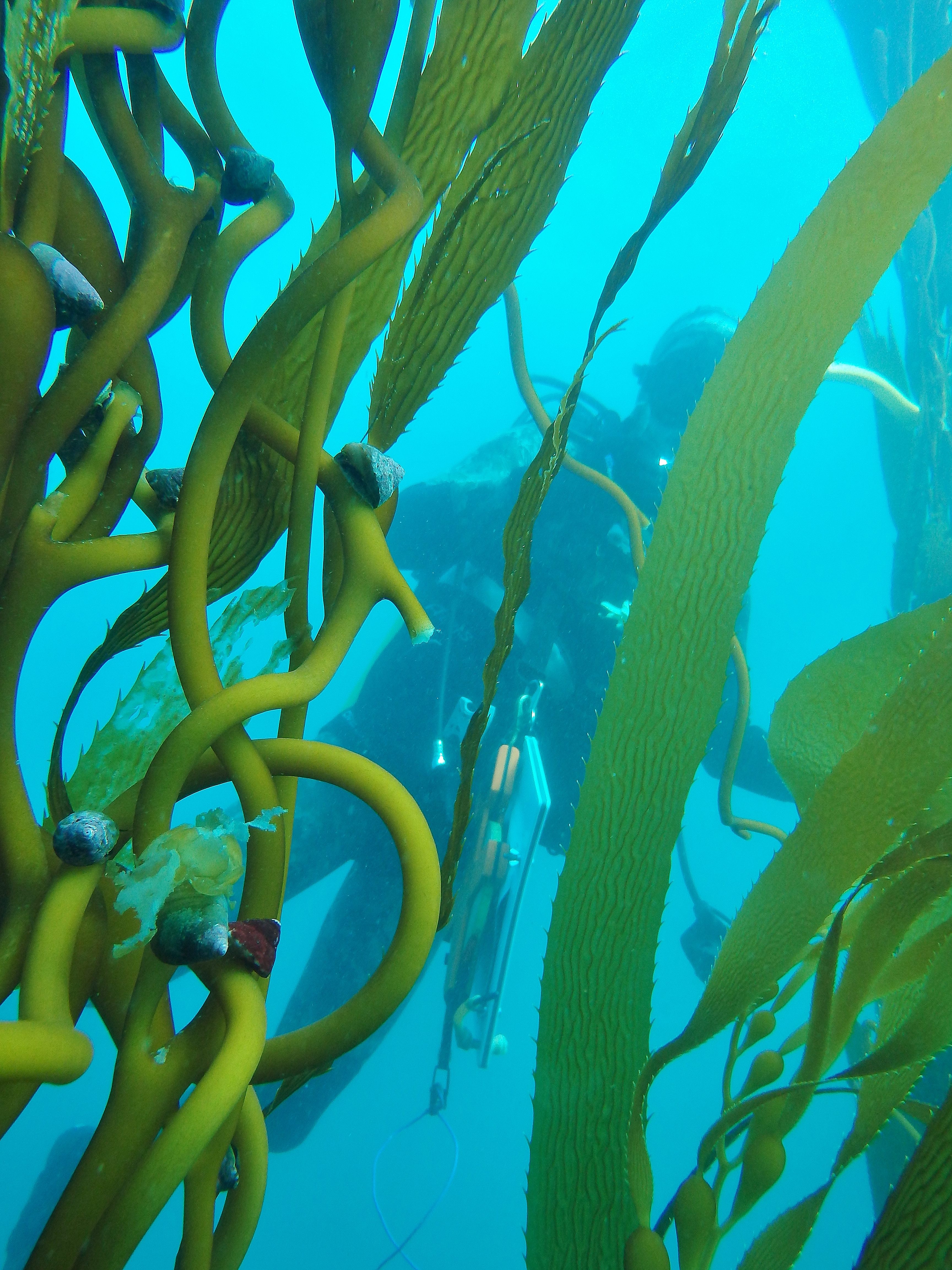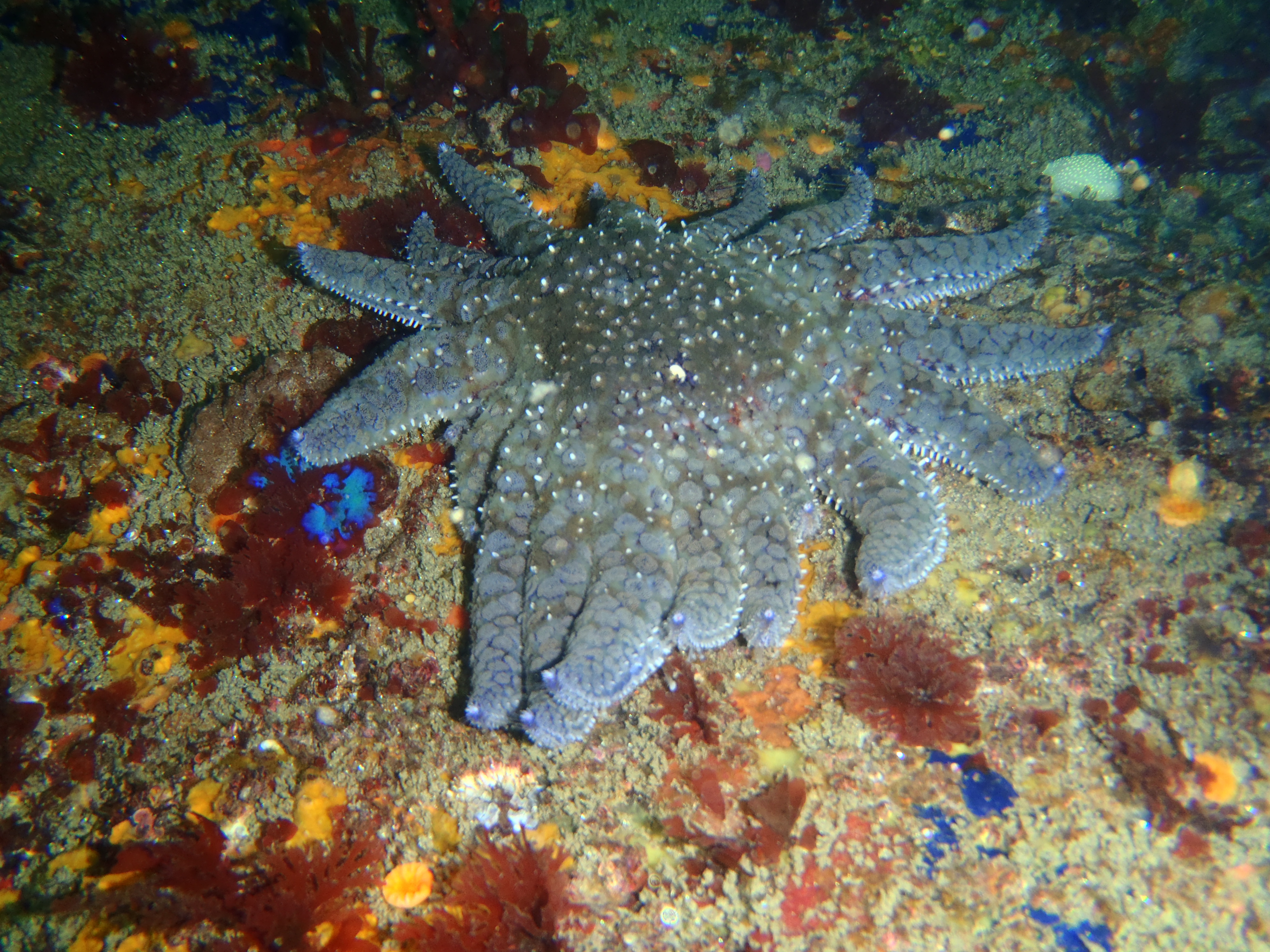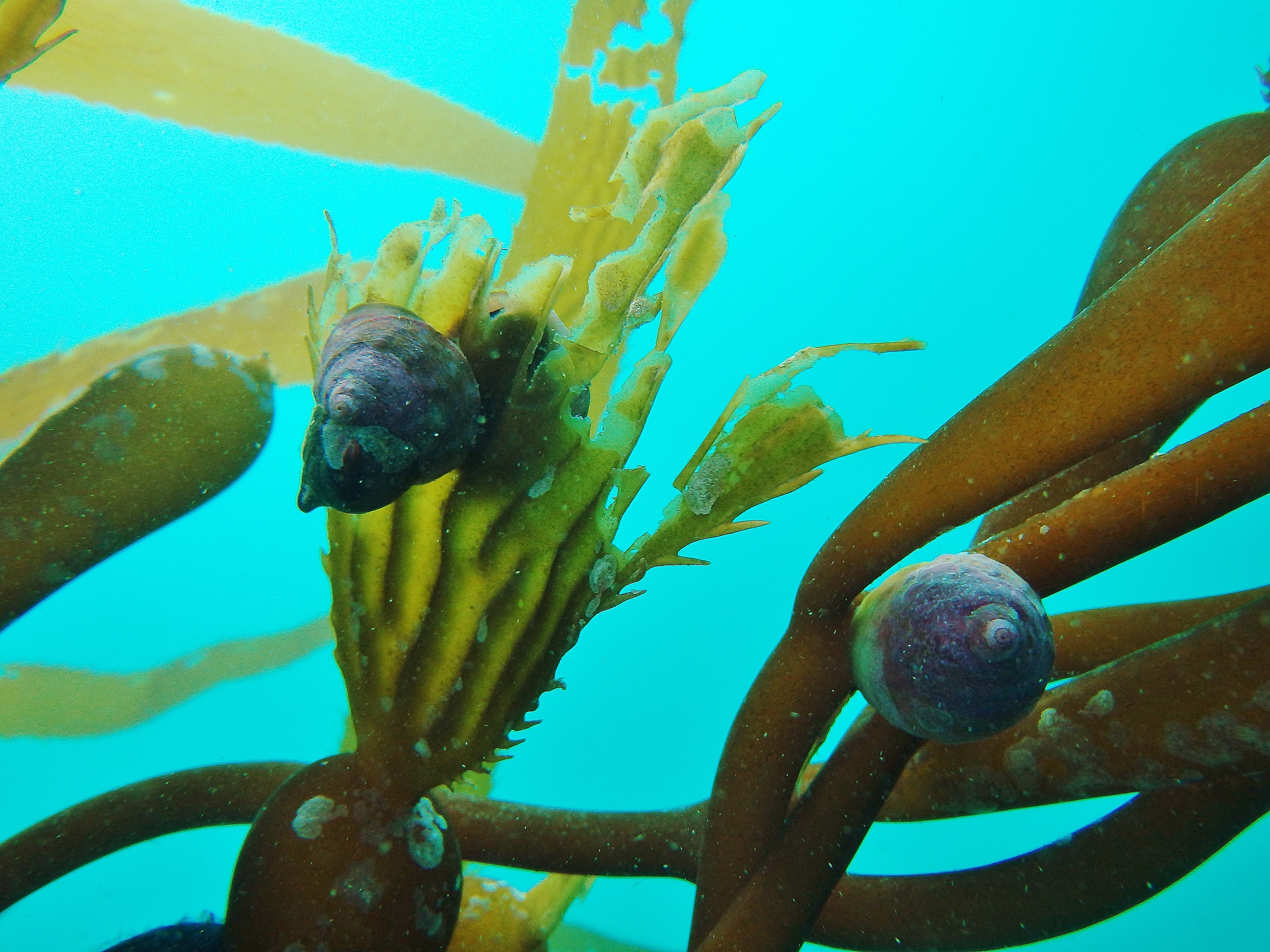October 12, 2016

Tegula snails grazing in kelp forest ecosystem. Photo credit: Lynne Wetmore
In northern and central California kelp forests, sea stars are the main predators on a number of macroalgal grazers including the herbivorous turban snails (Tegula spp.), which are highly abundant and strongly associated with giant kelp. Since Summer 2013, a severe outbreak of wasting disease along the Pacific coast has decimated sea star populations ranging from southern Alaska to Baja California. Pisaster spp. and Pycnopodia helianthoides (sunflower sea star) have been particularly impacted by the epidemic, and on many reefs, these historically abundant predators have been effectively removed from local food webs. For the past year, Dr. Todd Anderson (SDSU) and his doctoral student Lynne Wetmore (SDSU-UC Davis) have studied the recent wasting disease outbreak as a model system to evaluate the importance of predatory sea stars in regulating kelp forest grazing activity and assess potential ecological consequences of future epidemics.
Marine grazer populations are controlled by a combination of predation mortality and food availability, which is often the limiting factor for reproduction. In kelp forest ecosystems, predators can play an important role in regulating local grazing impacts on macroalgae either directly or indirectly. For example, seastars may prey upon Tegula and reduce their numbers (direct), or the mere presence of seastars may inhibit Tegula’s foraging activity and access to algal food sources (indirect). Removal of critical predators from coastal food webs has the potential to drive ecosystem-level “trophic cascades,” where rapid grazer proliferation and subsequent overconsumption of macroalgae can result in substantial habitat loss. Throughout the northeastern Pacific, regional shifts from kelp forests to urchin barrens have already been attributed to the decline of otters and other urchin predators from overfishing. If sea star predation plays a similar regulatory role for algal grazers such as Tegula, future mass mortality events could induce cascading losses of kelp forest habitat along the California coast.

Sunflower star (Pycnopodia helianthoides). Photo credit: Miranda Brett
The recent wasting epidemic provided a unique research opportunity to assess sea star-Tegula regulation on an ecologically relevant, reef-wide scale that could never have been achieved through traditional experimental manipulations. Because localized disease impacts were highly patchy, some reefs experienced complete removal of predatory sea stars (Pycnopodia, Pisaster), while similar reefs nearby continued to maintain local sea star populations. This spatial configuration allowed researchers to directly compare the grazing behavior and reproductive dynamics of wild Tegula populations on natural reefs where some threat of sea star predation remained present vs. natural reefs essentially devoid of predation pressure.
In fall and winter 2015, teams of divers surveyed wild Tegula populations in kelp forests off the coast of Monterey, Big Sur, and San Luis Obispo. For each of the three areas, researchers chose one study reef where severe sea star wasting disease had removed all visible Pycnopodia and Pisaster (SS-), and one nearby control reef where predatory sea stars were present (SS+). Divers conducted field surveys of Tegula density, distribution, and algal association, and also collected snails to assess dietary composition and reproductive index. Researchers noted that even at SS+ sites, densities of predatory sea stars observed in surveys were well below historic population levels. No Pycnopodia were observed during the study, and average Pisaster counts along 30-meter transects ranged from 3.3 individuals at Big Sur to 11.8 in San Luis Obispo.

Tegula snails grazing on kelp. Photo credit: Lynne Wetmore
Despite low predator densities, researchers discovered distinct and consistent differences in the field distributions of Tegula at SS+ and SS- locations. At all three SS+ sites, approximately 90% of snails were observed grazing on giant kelp, which has low nutritional content but offers vertical refuge from predatory sea stars on the ocean floor. By contrast, only 48-53% of snails at SS- sites were observed on giant kelp. The remaining snails were found grazing on benthic red algae, a food source that is high in nutritional value but offers limited protection from predators. These observations were confirmed by stable isotope analysis of Tegula tissue, which integrates dietary choices over time.
Comparative dissections of SS+ and SS- snails revealed that expanded access to high quality food sources (e.g., red algae) in the absence of sea stars may significantly increase grazer reproductive investment. Snails collected from SS- sites had significantly larger gonads (% body weight) and a larger proportion of ripe gonads compared to snails collected from sites where sea stars remained present. Based on these results, it appears that predatory sea stars at SS+ sites may regulate Tegula population dynamics indirectly, primarily by altering grazer behavior and restricting nutrient intake and thus limiting reproductive rates, rather than directly by reducing grazer numbers through consumption.
In all three study regions, the low densities of sea stars remaining at SS+ sites were sufficient to limit Tegula grazing activity almost exclusively to nutrient-poor giant kelp. If minimal predator presence can effectively induce this behavioral fear response, grazer regulation in kelp forest food webs may be somewhat resilient to moderate disease outbreaks where small populations of sea stars remain present. However, if a severe wasting epidemic were to drive widespread regional sea star extinctions, expanded feeding opportunities for Tegula could lead to rapid population expansion, intensified grazing pressure, and potential ecosystem-scale impacts ranging from reduced biodiversity via depletion of slow-growing understory algal groups to complete loss of giant kelp cover after higher quality food sources are depleted.
Based on data collected in this study, researchers at SDSU and UC Davis are in the process of developing dynamic population models to predict the effects of future sea star wasting epidemics on regional Tegula populations, determine whether certain types of kelp forest habitat may be more vulnerable to overgrazing, and ascertain what level of sea star presence may be critical in maintaining grazer population regulation.
Dr. Todd Anderson is a Professor of Biology at San Diego State University and
Lynne Wetmore is a PhD candidate in the Joint Doctoral Program in Ecology at San Diego State University and UC Davis. COAST provided funding for this project:
Rapid Response Funding Program
Award# COAST-RR-2015-002, June 2015.
California Sea Grant
also provided funding for this project: California Sea Grant Development Program, Project No. R/HCME-19PD, July 2015.